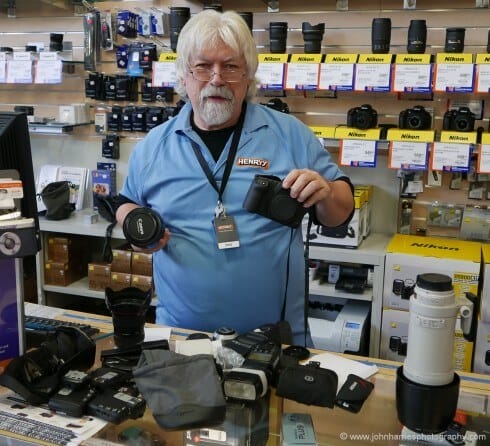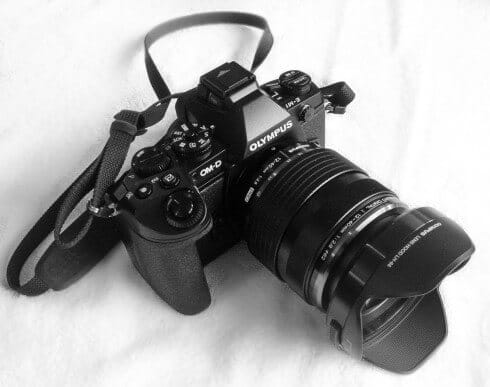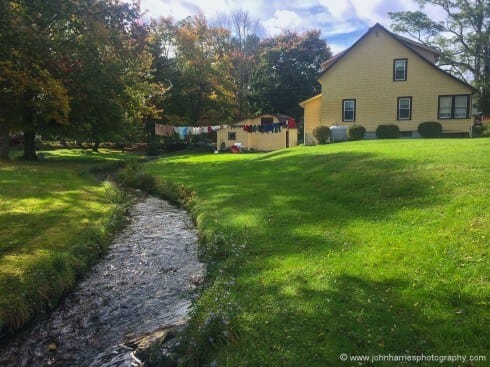
Deep down I had known this day was coming ever since I picked up this camera, but it took me quite a while to get over my 20-year relationship with big DSL gear—first film, then digital. Anyway, after a year of never getting my Canon kit out of the bag, I did it.
I just got rid of all of my big Canon photography gear:
- big bruiser full frame body,
- big L-series lenses,
- strobes and wireless triggers;
all of it. The works.
And you know what, I think I’m a better photographer without all that stuff. Less obtrusive, and more in tune with my surroundings. I sure feel lighter, and move faster, mentally and physically.

Not only that, the high end lenses for my new system (my in depth review here) are at least as good as anything Canon produces, and often demonstrably better. And they are less than half the size and less than half the price.
Oh yes, and my new camera is a better and easier to use video camera, at least for my purposes (with the best image stabilization in the industry), than anything Canon makes. Plus, my new favourite camera handles better, at least for me, than anything Canon has produced since the old film EOS 3.
And, now that we have fast focus tracking and fast long zooms on my new system, the only thing I’m giving up going away from full frame is the ability to make prints over 36″ wide, which I don’t do anyway. That’s it.
This is a pivotal moment in camera technology and a great time to be a photographer.

I have even finally found a pocket camera I can love. Great image quality, great handling, great viewfinder. Did I mention that it fits in my coat pocket? (I will do a review if enough people are interested, please leave a comment.)

And even my iPhone takes pretty good photos, although I hate using it for that because it’s an awkward camera to handle, at least in comparison to my purpose-built cameras.
Last time I was involved in a disruptive time like this in technology was when microcomputers arrived. Remember Wang, Data General and Digital Equipment Corporation? Nikon and Canon, are you listening?…No, didn’t think so…Watch out for the tar pits, guys.
By the way, the lead photo is of my pusher…er, camera salesman, Don, with all my old Canon gear as I traded it in on new goodies for my absolute favourite camera of all time.
Further Reading
Disclosure
I paid the same price as anyone else would for my new system and Canon has never done anything bad to me, other than forgetting to innovate lately.

Well done John – its incredible how much all that big glass weighs!
John
I have followed your lead – gave up tons (30 years) of heavy Nikon and am now an avid Fuji X Pro 1 user with the a handful of beautiful XF lenses. Quality is on a par, or better (?) than my Nikon but the biggest benefit is I am “loving” photography all over again. In time I will probably get the Fuji XT1 but in no rush…just loving not carrying all that weight, everything “fits” in my hands, and the photo quality is beautiful.
BTW, I would love to see your review of the Lumix, particularly as I’m hooked on the X Pro 1.
Regards
Steven
I might add that my newest lens, an 18-300mm Nikon really is a life saver on a boat. I used to have to keep swapping lenses, worrying when I put the caps, things rolling around etc. You used to compromise a lot these types of ‘do everything lens’ but they’ve come on a lot in that last few years. The Sigma equivalent is also good and only about £250.
I’d love to see a review of the Lumix pocket camera.
Hi John
Thanks for continuing to expand your Chapters on the subject of photography. I would appreciate your thoughts on the Panasonic point and shoot camera and why you selected it over other similar options. Unrelated to this posting, I am hoping that you will address the role of photo editing and just how much this plays into camera selection.
Thanks, Jim
I’d love to see a review of the Lumix too. I’m all about the pocket camera now.
It will be interesting to read more about your Lumix camera.
Tell us about it! Thanx
Interesting and agreed John.
It took me a long time to get over losing Kodachrome 25 (and the nice light Minolta – another loss – I used to expose it). I have steered away from the big DSL’s for just that reason – big and heavy. I do however like to have images that I can get to a decent size or crop, without thinking of K25 all over again. I also like to have a half decent camera with me at all times.
My solution is Nokia Lumia (41MP or 20MP, depending which one you go for, and both with 8 element Zeiss lenses). That solves the ‘pocket camera’ problem for me, then a lightweight DSL (currently Sony – the successor to Minolta) for the more serious stuff, when I can be bothered carrying a camera bag around my waist.
I know the ‘really wide to really long’ lenses are not perfect, but gee I don’t miss changing lenses, and can put up with a little distortion around the edges for that convenience.
If it isn’t fun, it’s work, and if it’s work we think of retirement. Keep it fun, as life is too short at the best of times.
David
John,
Please review that Lumix. (As an addition to my Canon EOS).
Thank you.
Last year I got a Sony A7R, in order to use my Leica 35 mm lens on a mirrorless digital camera. The sensor is full frame, 36 MP, fantastic. For B&W I still prefer film, but for color, I love this camera, and the compactness of the mirrorless systems.
Awww let’s cut John some slack and enjoy the Holidays; here’s that review of the Lumix: http://www.dpreview.com/reviews/panasonic-lumix-dmc-lx100
I was thinking his is DMC-LX7 – but I may be wrong.
LX100 cost double so it will be actually interesting to compere this two models.
We could probably find some good technical reviews on Internet, but I will be more interested in some personal opinion.
It will be also nice to know some details which are usually omitted in reviews like battery life, how easy it is to charge when on boat etc.
Things which are not essential but useful to know.
Hi All,
Looks like there is interest in my take on the LX100. I will work with it some more and then, assuming the muse hits, write something on it, I would guess some time mid-winter.
In the mean time, as Richard points out, there are plenty of very good technical reviews on the internet. Like him, I like the ones from dpreview he links to.
In fact, as Arek rightly points out, what I will do is not really a review, but (as usual) more a piece on how the camera fits into voyaging and my personal style, as well as my reasons for choosing it over the several very good competitors in high end pocket (just) camera space.
Anyway, it’s not the first time that one of your posts collides uncannily with my preoccupations of the moment. My eldest daughter wants a camera for Xmas. We have the Panasonic FZ200 and were about to buy one for her, and boom you show us the LX100: it looks a tad too sophisticated for our needs but I looked the LX7 and this might be the right fit for her. The primary factor for going Panasonic were those Leica lenses. Thanks! (I’m still interested in your take on them).
Hi Richard,
Hum, the LX100 is a pretty specialized camera: Fast, but short reach lens; great image quality; bigger than many of the type; the price of an interchangeable lens camera, but with a fixed lens.
I’m guessing that if general photography is your thing and you are only going to have one camera you might be better off with a super zoom like the FZ200, or save a bunch and go LX7. (I could not live with the LX7 because I must have a viewfinder.)
Also keep in mind that while very nice and a great lens the “Leica” is simply branding. It’s not a real Leica lens with that distinctive Leica look…with the price to match! The Oly high end lenses are just as good, and probably better.
Also, the handling on the LX100 is very different that the other two. I love it, but not everyone will. If you tend to shoot in auto mode, the interface will not be used and is not worth paying for.
Yep general photography is the application. There are so many choices in the market that, if you are not a professional (or knowledgeable amateur) you have to go with a brand you like or rely on educated advice like yours.
Hi John
Just a question (as I’m considering swapping my FX Nikon gear for the OMD5-II).
Why did you rule out getting an APS-C sized Canon? That way you could still get a lighter camera, the sensor size is larger than the micro 4/3, and you could still use your existing Canon lenses if needed. Plus you’d still have the big camera for those special shots of needed.
Nikon as a D5500 which is pretty small and light, maybe easier to handle than the OMD, and I’d keep the D700 for the photography projects I do from time to time.
Be interested in your views – and please tell me if I’ve missed something fundamental!
David
Hi David,
Basically because the OMD EM1 is a way better camera than most of the Nikon or Canon APS offerings. And because of ditching the mirror and reducing the flange distance the lenses are about half the weight and size of lens for and APS. For the same reason the body is way smaller. And to drive the last nail in the coffin, the Oly has in-body stabilization which makes every lens stabilized.
Also the Oly glass is, in my experience, better than even Canon L glass and it’s half the price.
And finally the difference in size and quality between APS any micro 4/3 sensors is, despite all the gnashing of teeth on the forums, meaningless.
More here: https://www.morganscloud.com/2014/02/16/the-ultimate-cruiser-camara/